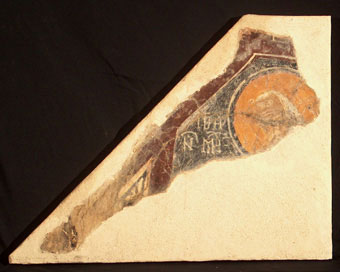
The bishop of Athens, Michael Choniates, (1233\1234), southern chapel of Hagios Nikolaos in Penteli Cave, 59,5 x 78,5 cm.
 |
 |
 |
 |
Michael Choniates, Penteli Cave
Area: Byzantine and Christian Museum, Athens
Date: 1233/1234 A.D.
Description:
The representation, which is preserved in bad condition, decorated along with other saints the southern chapel of the church. The special features of his figure with the tall, wrinkled forehead, the crooked nose and the peculiar hairstyle display a realistic prosopography of the bishop. This assumption is confirmed by the fact that Choniates’s portrait with similar characteristics has been traced in the wall paintings of another church in Attica, Hagios Petros in Kalyvia Kuvara. Michael Choniates, who came from Chones in Asia Minor, became bishop of Athens in 1118 and remained till 1204, when the town was seized by the Franks. He became self-exiled in Kea and later ended up in the monastery of Prodromos in Thermopyles, where he died in 1222. He was one of the most important learned men and a lover of antiquity with a strong personality and vivid activity. He succeeded in making Athens an important spiritual center, while he bequeathed a noteworthy writing work (letters, poems, etc.). Moreover, he set up a significant library. There are at least two Michael Choniates’s portraits in monuments in Attica, where he is depicted with a halo denoting that they were created after his death. This indicates that the bishop’s humanistic activity was extremely appealing among his flock, which honored his memory in this way.
Date: 1233/1234 A.D.
Description:
The representation, which is preserved in bad condition, decorated along with other saints the southern chapel of the church. The special features of his figure with the tall, wrinkled forehead, the crooked nose and the peculiar hairstyle display a realistic prosopography of the bishop. This assumption is confirmed by the fact that Choniates’s portrait with similar characteristics has been traced in the wall paintings of another church in Attica, Hagios Petros in Kalyvia Kuvara. Michael Choniates, who came from Chones in Asia Minor, became bishop of Athens in 1118 and remained till 1204, when the town was seized by the Franks. He became self-exiled in Kea and later ended up in the monastery of Prodromos in Thermopyles, where he died in 1222. He was one of the most important learned men and a lover of antiquity with a strong personality and vivid activity. He succeeded in making Athens an important spiritual center, while he bequeathed a noteworthy writing work (letters, poems, etc.). Moreover, he set up a significant library. There are at least two Michael Choniates’s portraits in monuments in Attica, where he is depicted with a halo denoting that they were created after his death. This indicates that the bishop’s humanistic activity was extremely appealing among his flock, which honored his memory in this way.




